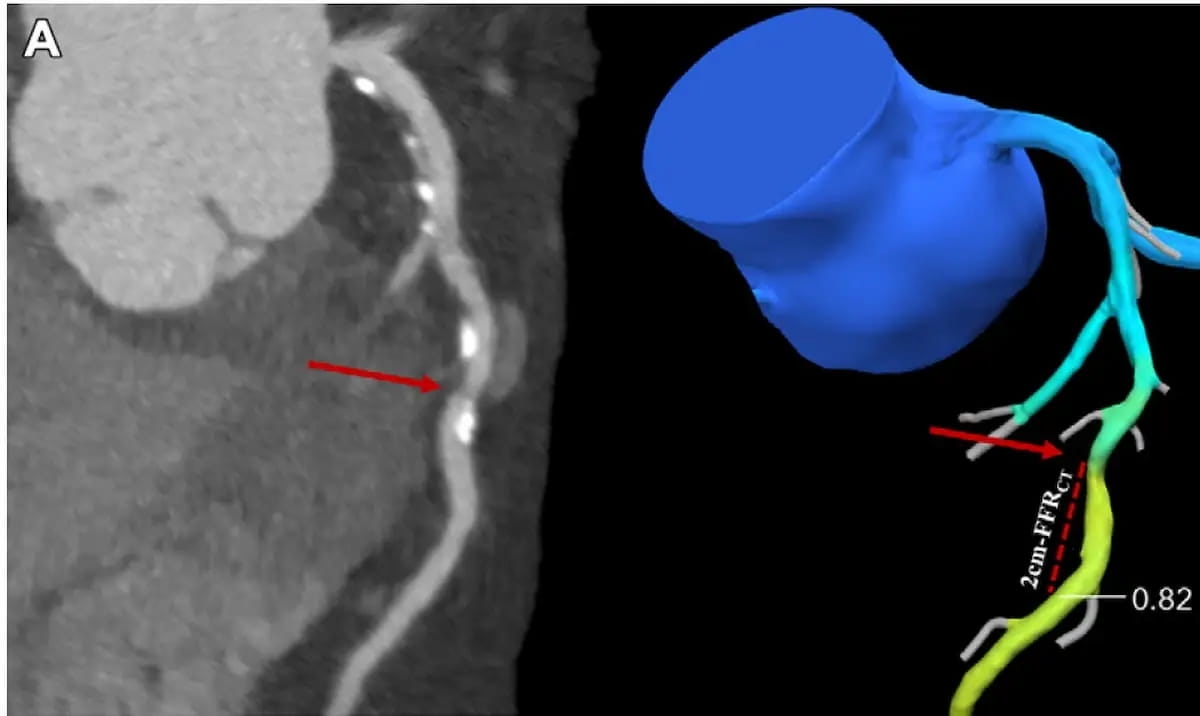The combination of computed tomography (CT)-based fractional flow reserve (CT-FFR) and coronary computed tomography angiography (CCTA) may lead to reduced short-term use of invasive coronary angiography (ICA) in patients with suspected coronary artery disease (CAD) with little impact upon major adverse cardiovascular event (MACE) rates at 90 days and one year.
In a 17-center randomized controlled trial, recently published in Radiology, researchers compared the combination of CT-FFR and CCTA versus CCTA alone in guiding subsequent care for 5,297 patients (mean age of 63.5) with stenosis ranging between 25 to 99 percent at CCTA.
In a 90-day follow-up, the researchers found that ICA was performed in 263 out of 2,633 patients in the adjunctive CT-FFR group (10 percent) in comparison to 327 out of 2,640 patients in the CCTA-alone cohort (12.4 percent), equating to a 19.4 percent reduction in the 90-day ICA rate when clinicians employed adjunctive CT-FFR.
The study authors also found no significant differences between the adjunctive CT-FFR and CCTA-alone groups with respect to MACE rates at 90 days (0.5 percent vs. 0.8 percent) and one year (2.9 percent vs. 2.8 percent).
In light of other research demonstrating that over 62 percent of the estimated 12 million cardiac catheterization procedures performed annually worldwide do not reveal obstructive CAD, the study authors suggested that adjunctive CT-FFR may provide greater clarity on the necessity of ICA procedures in this patient population.
“ … It is crucial to determine which patients should undergo ICA and revascularization after CCTA. In our study, we did not observe a statistically higher rate of obstructive CAD at ICA in the CCTA plus CT-FFR group (80.2%) than in the CCTA-alone group (80.1%),” wrote Bangjun Guo, M.D., who is affiliated with the Department of Radiology at Jinling Hospital and the Affiliated Hospital of Medical School at Nanjing University in Nanjing, China, and colleagues.
Three Key Takeaways
- Reduced invasive coronary angiography (ICA) rates. The combination of CT-FFR and CCTA led to a 19.4 percent reduction in the rate of ICA at 90 days compared to CCTA alone, suggesting CT-FFR may help reduce unnecessary invasive procedures in patients with suspected CAD.
- No significant impact on major adverse cardiovascular events (MACEs). At both 90 days and one year, there were no significant differences in MACE rates between the CT-FFR plus CCTA group and the CCTA-alone group, indicating that the adjunctive use of CT-FFR does not compromise patient safety.
- CT-FFR as a prognostic tool. CT-FFR may provide functional evaluation and prognostic insight with respect to coronary artery stenosis. Lower CT-FFR values were associated with higher MACE rates, reinforcing its predictive value in guiding decisions regarding deferral of ICA and revascularization.
The researchers also noted the predictive value of CT-FFR with respect to MACE rates, noting lower CT-FFR values in those with MACE.
“CT-FFR provides a functional evaluation of coronary artery stenosis with prognostic insight in patients with CAD. … It appears physicians opted to defer ICA and revascularization because of CT-FFR greater than 0.80, and the low MACE rate in these individuals demonstrates the safety and efficacy of this approach,” emphasized Guo and colleagues.
(Editor’s note: For related content, see “CT-Based Fractional Flow Reserve Analysis Improves Five-Year Outcomes After Major Vascular Surgery,” “What a New Meta-Analysis Reveals About Fractional Flow Reserve Assessment with Computed Tomography” and “Medicare to Cover AI-Powered, CCTA-Based Coronary Plaque Analysis and Quantitative Coronary Topography.”)
In regard to study limitations, the authors conceded the use of on-site CT-FFR software from one vendor and a 1.2 percent utilization rate of invasive FFR at ICA. They also acknowledged that the outbreak of the COVID-19 pandemic may have affected the management of patients at some of the study sites.
